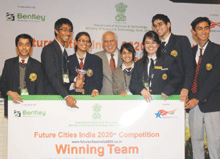 A team comprising Shruti Sahrawat, Neha Ahooja, Agrim Singh and Arjun Hans — all class XI students of Amity International School, Saket, Delhi –– was awarded the first prize in the ‘Future Cities India 2020 competition’, jointly organised by the Union ministry of science & technology and the US-based Bentley Systems. The competition initiated in 2006, is open to all schools in the Delhi national capital region. In the fourth edition of this annual event, 14 teams from Delhi schools sent in sophisticated entries. On January 18 the Amity International, Saket team was adjudged the winner.
A team comprising Shruti Sahrawat, Neha Ahooja, Agrim Singh and Arjun Hans — all class XI students of Amity International School, Saket, Delhi –– was awarded the first prize in the ‘Future Cities India 2020 competition’, jointly organised by the Union ministry of science & technology and the US-based Bentley Systems. The competition initiated in 2006, is open to all schools in the Delhi national capital region. In the fourth edition of this annual event, 14 teams from Delhi schools sent in sophisticated entries. On January 18 the Amity International, Saket team was adjudged the winner.
The annual competition required participating teams to submit a blueprint for restoring and remodeling Chandni Chowk, the bustling 300-year-old Mughal era settlement and the busiest wholesale market of Delhi. For the preliminaries which began in September last year, entrants were obliged to submit a conceptual essay. The shortlisted teams which included a teacher from the school, were provided a mentor from industry/government departments and trained in the use of design software by Bentley, with an expenditure fund of Rs.5,000 to develop a three-dimensional model. Following an impressive presentation to a jury of experts, on January 18 the Amity International team bagged the first prize: a cash award of Rs.100,000 and trophy presented by the Union HRD minister Kapil Sibal in New Delhi.
The winning team presented some brilliant ideas to upgrade and reorient Delhi’s heritage landmark. It suggested piezo electricity, microbial fuel cell power, solar panels for street lighting, electrical rickshaws, underground parking, carbon nano tubes for reducing water wastage, rain-water harvesting and converting havelis into heritage hotels and the Town Hall (headquarters of the Municipal Corporation of Delhi) into a tourist hotspot. “Our development plan focuses on restoration rather than dest-ruction of Chandni Chowk’s heritage status and flavour,” explains Arjun Hans.
The youthful energy of the Amity International team was ably guided by principal Bharti Sharma, and followed a basic research methodology. “We recced the place five times, went to the Town Hall library and referred to old manuscripts on the area, interviewed local residents of all generations, and used the internet extensively,” says Neha Ahooja.
The judges apart, Kapil Sibal was impressed by the structure of this competition. “It is a great collective learning activity which adds to the body of knowledge on urban planning and development. I hope all stakeholders will take this learning competition to the whole of India,” said Sibal, who also represents Chandni Chowk constituency in Parliament.
Autar Nehru (Delhi)
Kartiki Kane
 In the summer of 2007 when Pune-based Vilas Kane decided on the spur of the moment to let his then ten-year-old daughter Kartiki use his videocam, he unwittingly unearthed a natural talent which could well become her career. “The first shot she took with the camera was perfect. I knew right then that all she needed was encourage-ment,” recalls Kane. Two years later, true to her promise, Kartiki has produced and directed a short film titled Manee: The Story of a Successful Mother, which is winning countrywide encomiums in film festivals.
In the summer of 2007 when Pune-based Vilas Kane decided on the spur of the moment to let his then ten-year-old daughter Kartiki use his videocam, he unwittingly unearthed a natural talent which could well become her career. “The first shot she took with the camera was perfect. I knew right then that all she needed was encourage-ment,” recalls Kane. Two years later, true to her promise, Kartiki has produced and directed a short film titled Manee: The Story of a Successful Mother, which is winning countrywide encomiums in film festivals.
Centred around the transformation of a common alley cat into a loving mother protective of her litter, the 15-minute film traces the life and situations of Manee, the protagonist cat (and some other felines in the neighbourhood) to capture valuable footage which has translated into a heart-warming and delightful film. “I shot 11 hours of footage which has been reduced to a 15-minute film. It was a tall order, but I managed to maintain the story line and even chose the music. The only help I took from my dad was for script writing and post-production work,” says Kartiki, a class IX student of Pune’s Karnataka High School.
Pleasantly surprised by public and critical acclaim that Manee has received, Kartiki is typically modest. “The film has been appreciated wherever it has been shown, mainly because of its simple and direct narrative style,” she says.
Now busy preparing for her school exam which will promote her to class X, Kartiki nevertheless, makes time for her next major project. “It’s tentatively titled Jungle In Concrete and focuses on several birds, animals and insect species of this region and how they adapt themselves to the city environment,” she says, adding that she has already shot 20 hours of footage, which she hopes to edit with her dad’s help over the next two months.
Meanwhile, Kartiki has started learning the finer nuances of film-making. “The traditional weakness of Indian cinema is poor research and unreal story lines. One reason why Manee came out so well is that I thoroughly researched the community of cats in my locality and knew all of them by name. I spent many hours wandering around observing the behaviour of cats, dogs, birds and squirrels. This watching and tracking made for a natural film with a realistic storyline,” says this young film director, endowed with insight which belies her age.
Huned Contractor (Pune)